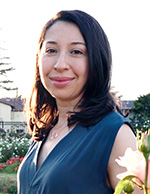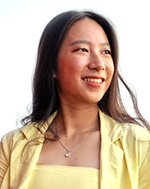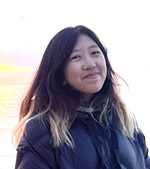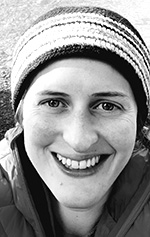2022 Sejong International Sijo Competition
Winners | Judges | Winning Entries
Winners
| One Division | |
|---|---|
| Winner | Katie Yen Bentonville, AR, USA sijo |
| Runner-up | Sasha A. Palmer Baltimore, MD, USA sijo |
| Honorable Mention |
Erica Fransisca Jakarta Barat, Jakarta, Indonesia sijo |
| Seunghui Lily Ha Naperville, IL, USA sijo |
|
| Brittany Mishra Battle Ground, WA, USA sijo |
|
| Deborah J. Shore Easton, PA, USA sijo |
About Winners
Katie Yen
winner

I am a lover of language– written, spoken, and sung, which led me to study linguistics and foreign languages in college. My curiosity led me to study Korean culture and hangeul on my own, after which I discovered the art of sijo from the Sejong Cultural Society. The poetry form of sijo felt both freeing and limiting to me, in that I challenged myself to shape something beautiful and powerful with the succinct use of the most impactful words.
It is sometimes that which cannot be expressed with words that eludes us the most, which we attempt to express through other love languages– the sharing of food, an act of kindness, a warm embrace. In my sijo, GRANDMOTHER'S HAIR, I recall how there is an infinite history passed down to me by those loved ones who are no longer here, and how little of it was actually verbalized when they were still around. There is so much that I would ask my ancestors if I could, yet all their words are still here, written in my own flesh, and in yours, too, dear reader. I encourage you to share your own stories with your loved ones, whether through pages and pages of sijo or around the dinner table.
I am a mother, a writer, a novelist and a poet. You can find my work at katieyen.com and follow me
Sasha A. Palmer
runner-up

Thank you, Sejong Cultural Society, for recognizing my sijo. Congratulations to the winner, and honorable mentions – I look forward to your poems! I read sijo—both classic, and contemporary—for enjoyment, as well as for a better understanding of this poetry form.
Although I have experimented with free verse, I prefer writing formal—especially short form—poetry. I find its technical, and thematic constraints liberating. They help me focus, and get rid of fluff, as I try to create a poem, in which every word is meaningful. A sijo is a challenge, and a lot of fun to write!
Erica Fransisca
honorable mention

I’m a born and bred Indonesian who studied English Literature in the UK. Today, I’m mostly a freelance writer but have also worked (or still do) as a narrative designer and outreach manager. Although I’ve always been fascinated by words and their ability to touch on our emotions, I never seriously considered publishing my own works until recently.
I came across both the sijo form and competition from a writing website and was immediately drawn to its rhythmic and lyrical quality. Indeed, this has inspired me to explore more forms of poetry and writing from different cultures around the globe, including my own.
My sijo was inspired by my maternal and paternal grandfathers who passed away within four years of each other—one just before I started university, and the other after. Sometimes when I see the chair, the sofa, or the bed that was once “their spot”, I can’t help but wonder if some of us still hope for them to come back and be there again. It’s impossible, but I think there will always be a part of you that indulges in this sort of wishful thinking.
Seunghui Lily Ha
honorable mention

I am a child of South Korean immigrants and moved to the US when I was one. My identity is composed of two nations. I am currently a high school junior from Naperville, Illinois. I serve as an executive editor for my school’s literary magazine and the assistant editor-in-chief of my school’s newspaper.
The arts, particularly poetry, have always inspired me. The passion and sentiment for them make me feel human. I enjoy reading poems in my daily life, and it brings calmness to the hectic and turbulent outside world. I love to experiment with different genres of poetry writing, though free verse feels most close to home. When I came across the Sejong Cultural Society and its resources, I was fascinated by sijo. Not only does it portray strong messages with powerful words, but also through the rush of emotions through short phrases. I have always had an interest in cultural interactions on a global scale, and since freshman year, I have been volunteering to teach Korean adoptees around the world the culture and language of Korea every weekend.
My sijo was inspired by the complexity that the Coronavirus Pandemic brought forth to us, and the idea of a twist for a date during social distancing came to me one day. Although the brainstorming process of a creative and fresh idea for a sijo took longer than expected, the final draft was nearly identical to my first. The COVID-19 pandemic brought confusion and anxiety to all of us and I wanted to create a poem in sijo form that depicted the situation in a more humorous and light-hearted manner.
In 2021, I was selected as a winner of the Gwendolyn Brooks Youth Poetry Award, organized by Illinois Humanities in partnership with the Poetry Foundation, Brooks Permissions, and UChicago Arts. I have also won several awards in poetry for Scholastic Art and Writing Awards.
Brittany Mishra
honorable mention

I’m Brittany Mishra and I am a Senior Supply Chain Buyer for a medical device company. In my spare time, I write poetry in many forms and styles. My poems have been published in Painted Bride Quarterly, Spoon River Poetry Review, Chestnut Review, and in many other journals.
In June 2022, I heard about the Sijo form and this competition while attending the Community of Writers workshop just north of Lake Tahoe. I learned the details and specifics of the form through a friend and through the Sijo Competition website. I found the form and its restrictions inspiring. It forced me to make choices in language and image that I never considered before. I fell in love with how musical and rhythmic each line can become.
Deborah J. Shore
honorable mention

Sijo is a new form for me. Another writer had mentioned this competition on a social media group for poets. So I browsed resources on sijo at the Sejong Cultural Society page. I became curious about the form’s potential to introduce new creative writers to concepts important to Western forms such as word play, caesura, and turns while immersing them in another culture—acting as a bridge between the two.
Since the three line format is more in keeping with the historical tenor of sijo, I began by writing this poem. Sustained meditations or simpler images seem to help maintain the integrity of a sijo’s long lines. I’ve also enjoyed the contemporary format where a sijo is divided into six short lines on the page—in my novice experience, allowing for a higher energy poem with more diverse imagery. They’re both wonderful to explore.
I am housebound with illness but was fortunate to be inspired by an observation of the natural world from my apartment window. I’ve previously placed first in poetry competitions at the Anglican Theological Review and the Alsop Review.